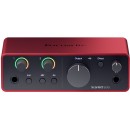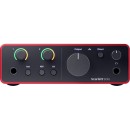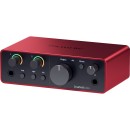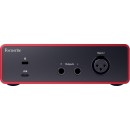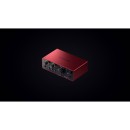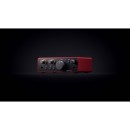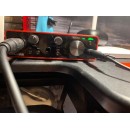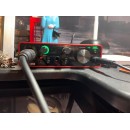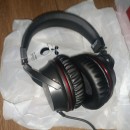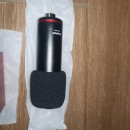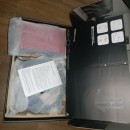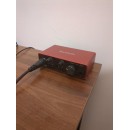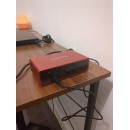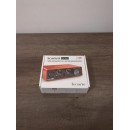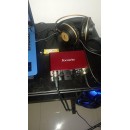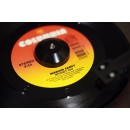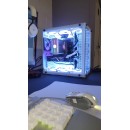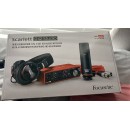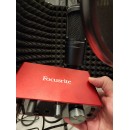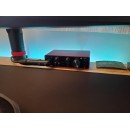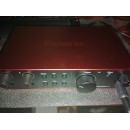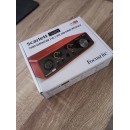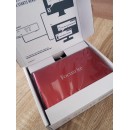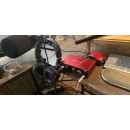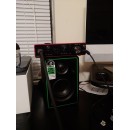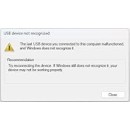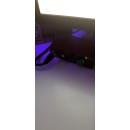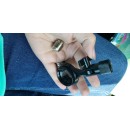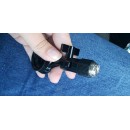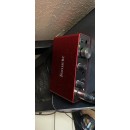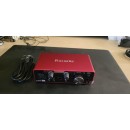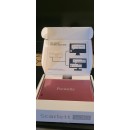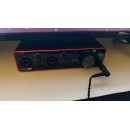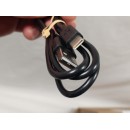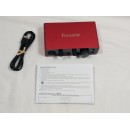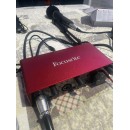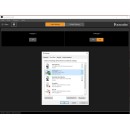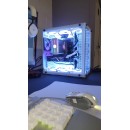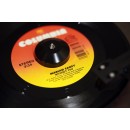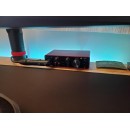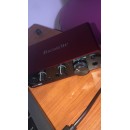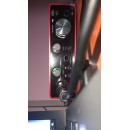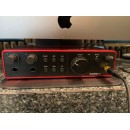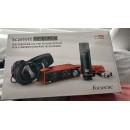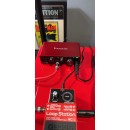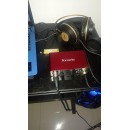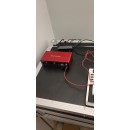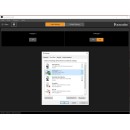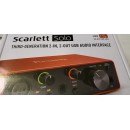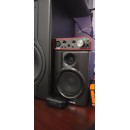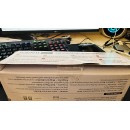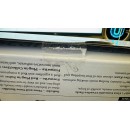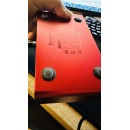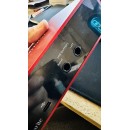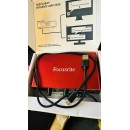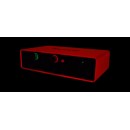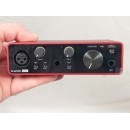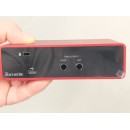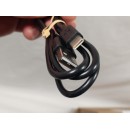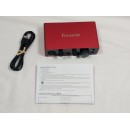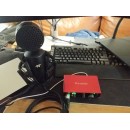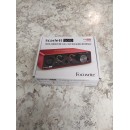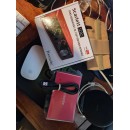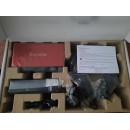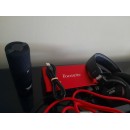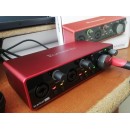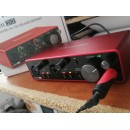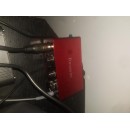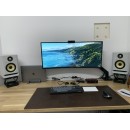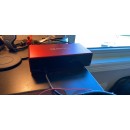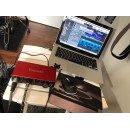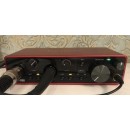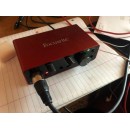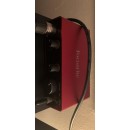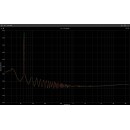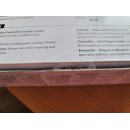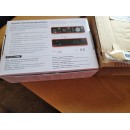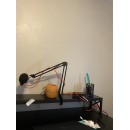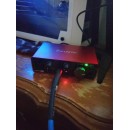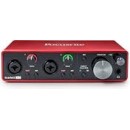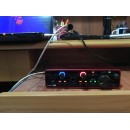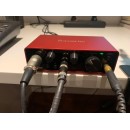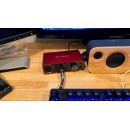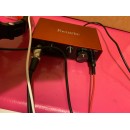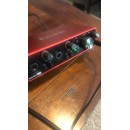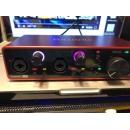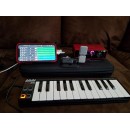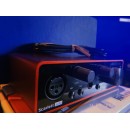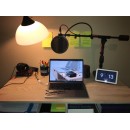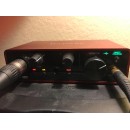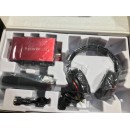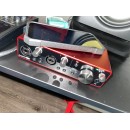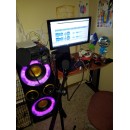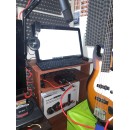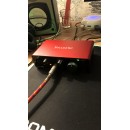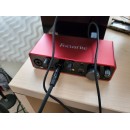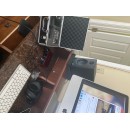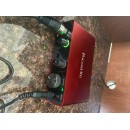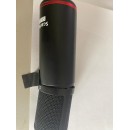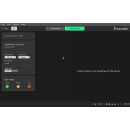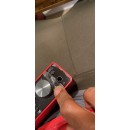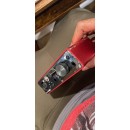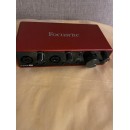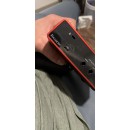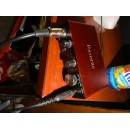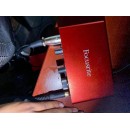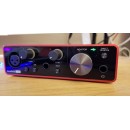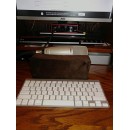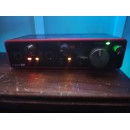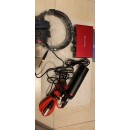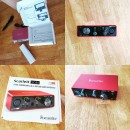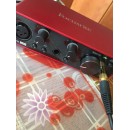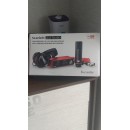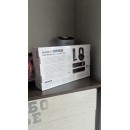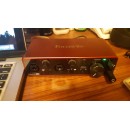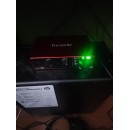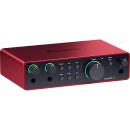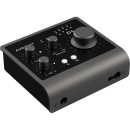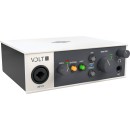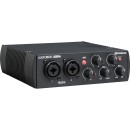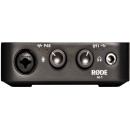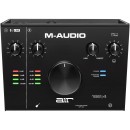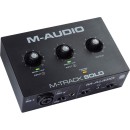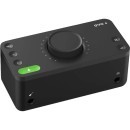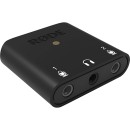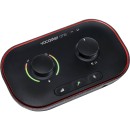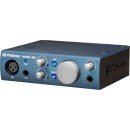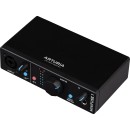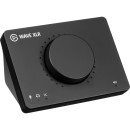Focusrite Scarlett Solo USB-C Audio Interface (4th Generation) Review
- High-performance 24-bit/192kHz AD-DA converters
- Single upgraded Scarlett mic preamp with Air mode
- Instrument input with high headroom for guitars and basses
- Balanced outputs for clean audio playback
- Direct Monitor feature for zero-latency tracking
- USB-C connectivity for fast and reliable data transfer
- Included software bundle with Ableton Live Lite, Pro Tools First, and more
- Compact and portable design for easy transport
- Quick Start tool for hassle-free setup
Specifications, Advantages, and Disadvantages
The Focusrite Scarlett Solo USB-C Audio Interface (4th Generation) is a compact and powerful audio interface designed for musicians, podcasters, and home studio enthusiasts. Featuring a sleek and durable design, the Scarlett Solo offers high-quality audio performance with its upgraded preamps and converters, ensuring crystal-clear sound recording and playback. The interface supports up to 24-bit/192kHz resolution, providing professional-grade audio fidelity for all your recording needs.
Equipped with a single Scarlett mic preamp, the Scarlett Solo delivers a clean and natural sound, complete with the iconic Air mode that adds brightness and presence to vocals and instruments. The interface also includes a high-headroom instrument input for directly connecting guitars and basses, making it versatile for various recording scenarios. The USB-C connectivity ensures fast and reliable data transfer, with low latency monitoring through the direct monitor circuit.
The Scarlett Solo comes bundled with a comprehensive software package, including industry-standard tools like Ableton Live Lite, Focusrite’s Red Plug-in Suite, and a three-month subscription to Avid Pro Tools Artist. This makes it an excellent choice for both beginners and seasoned professionals looking to enhance their recording capabilities. Compact, user-friendly, and packed with features, the Focusrite Scarlett Solo USB-C Audio Interface (4th Generation) is a top-tier choice for high-quality home studio recording.
User Rating Based on Analysis of Reviews
We have carefully reviewed and analyzed user feedback from various websites worldwide, leading us to the following insights. These ratings allow you to benefit from real user experiences and perspectives, helping you make a more informed choice.
Purchase Value
85% of users were satisfied with the purchase value of the Focusrite Scarlett Solo USB-C Audio Interface (4th Generation). Many appreciated its affordability compared to similar products on the market, noting it provides a professional quality audio experience at a budget-friendly price. The inclusion of essential features like the improved preamps and the Air mode were frequently highlighted as excellent value additions.
15% of users expressed dissatisfaction with the purchase value, primarily due to expectations of more features that are available in higher-priced models. Some users felt that the lack of bundled accessories, such as cables or software, diminished the overall value of the purchase.
Quality of Material
90% of users found the quality of material to be excellent. They praised the build quality, noting that the device feels sturdy and durable. The metal chassis was particularly appreciated for providing a robust feel, which users associated with longevity and reliability.
10% of users were dissatisfied with the quality of material. Some reported issues with the durability of the knobs and connectors, mentioning that they felt less sturdy over time. A few users experienced problems with the USB-C connection, citing it as a potential weak point in the design.
Ease of Use
88% of users were satisfied with the ease of use of the Focusrite Scarlett Solo. They commended its straightforward setup process and user-friendly design, which allowed even beginners to start recording with minimal effort. The clear labeling and intuitive layout were also frequently praised.
12% of users found the device less user-friendly than expected. Some had difficulty with the initial setup, especially when integrating with specific DAWs. Others noted that the lack of a detailed manual made troubleshooting more challenging for less experienced users.
Sound Quality
92% of users were highly satisfied with the sound quality provided by the Focusrite Scarlett Solo. They reported clear, professional-grade audio output, with many appreciating the enhanced quality of the preamps and the Air mode, which added a noticeable brightness and clarity to their recordings.
8% of users were not fully satisfied with the sound quality. Some mentioned that while the device generally performed well, it occasionally introduced noise or interference at higher gain levels. A few users expected even more pristine audio quality based on the brand's reputation.
Connectivity
87% of users were satisfied with the connectivity options of the Scarlett Solo. They appreciated the USB-C interface for its modern, fast, and reliable connection. Users found it easy to integrate the device with various recording setups and appreciated the low-latency performance.
13% of users faced issues with connectivity. Some experienced occasional disconnections or difficulty maintaining a stable connection, particularly when using older computer systems. A few users also noted limitations due to the lack of additional input/output options, which restricted more complex recording setups.
Software Integration
83% of users were pleased with the software integration capabilities of the Scarlett Solo. Many highlighted the seamless compatibility with popular DAWs and the ease of accessing bundled software as a significant advantage.
17% of users encountered challenges with software integration. Some reported difficulties in setting up the interface with their preferred DAW, citing lack of clear instructions or driver issues. Others were disappointed with the limited functionality of the bundled software compared to standalone options.
Portability
89% of users appreciated the portability of the Focusrite Scarlett Solo. Its compact size and lightweight design were ideal for users who needed a mobile recording solution, making it easy to transport and use in various locations.
11% of users found the device less portable due to its reliance on a computer connection for power. Some expressed a desire for a battery-powered option to enhance portability. Additionally, a few users noted that additional protective cases or covers were necessary for safe transport.
Durability
91% of users were satisfied with the durability of the Scarlett Solo. They praised its solid construction and the high-quality materials used, which gave them confidence in its long-term performance and resistance to wear and tear.
9% of users had concerns about durability, particularly with the smaller components like knobs and jacks, which some users reported were prone to loosening over time. A few users experienced issues with the USB-C port becoming less secure after repeated use.
Aesthetic Design
93% of users were highly satisfied with the aesthetic design of the Scarlett Solo. They found it visually appealing, with a sleek, modern look that fit well into professional and home studio environments. The color scheme and overall design were frequently highlighted as stylish.
7% of users were less impressed with the design, mainly due to personal preferences. Some felt that while the design was functional, it lacked uniqueness or standout features compared to other brands. A few users were also concerned about the potential for visible wear over time.
Customer Support
84% of users were satisfied with the customer support provided by Focusrite. Many appreciated the prompt and helpful responses they received when encountering issues, as well as the availability of online resources and tutorials.
16% of users were dissatisfied with customer support, citing long wait times and unhelpful responses in some cases. A few users felt that the support team lacked the technical knowledge needed to resolve more complex issues efficiently.
Latency
88% of users praised the low latency performance of the Scarlett Solo. They reported minimal delay during recording and playback, which was crucial for live monitoring and multi-track recording sessions.
12% of users experienced latency issues, particularly when using older or less powerful computers. Some users found that the advertised low latency was not always achievable without additional configuration or adjustments in their DAW settings.
Preamps
90% of users were impressed with the quality of the preamps in the Scarlett Solo. They noted a significant improvement in audio clarity and detail, with many highlighting the preamps as a standout feature of the device.
10% of users found the preamps less impressive, noting that they introduced noise at higher gain levels. Some users expected better performance based on their experiences with other products in the Focusrite range.
Driver Stability
86% of users were satisfied with the driver stability of the Scarlett Solo. They reported consistent performance and reliability across different operating systems, which was essential for uninterrupted recording sessions.
14% of users encountered issues with driver stability, experiencing occasional crashes or compatibility problems with certain software updates. Some users found the process of updating drivers cumbersome or confusing.
Input/Output Options
80% of users were content with the input/output options provided by the Scarlett Solo. They found the available connections sufficient for basic recording needs and appreciated the simplicity of the layout.
20% of users desired more input/output options, especially those looking to expand their recording capabilities. Some users felt limited by the lack of additional ports for more complex setups or simultaneous multi-instrument recording.
Brand Reputation
95% of users expressed trust in Focusrite's brand reputation, noting their history of producing reliable and high-quality audio interfaces. Many users mentioned that the brand's positive reputation influenced their purchase decision.
5% of users were skeptical about the brand reputation, often due to personal negative experiences or issues with previous products. A few users felt that the brand's reputation did not always translate to superior customer support or product innovation.
Compatibility
88% of users were satisfied with the compatibility of the Scarlett Solo with various systems and software. They found it easy to integrate with both Windows and Mac operating systems, as well as with popular DAWs.
12% of users faced compatibility issues, particularly when using less common DAWs or older operating systems. Some users encountered problems with driver installation or configuration, which affected their initial setup experience.
Setup Process
87% of users found the setup process for the Scarlett Solo to be straightforward. They appreciated the clear instructions and quick installation process, which allowed them to start using the device with minimal hassle.
13% of users encountered difficulties during setup. Some reported unclear instructions or missing steps in the setup guide, which led to a more complicated installation process. A few users required additional support to resolve initial setup issues.
Firmware Updates
82% of users were satisfied with the availability and effectiveness of firmware updates for the Scarlett Solo. They appreciated the improvements in performance and functionality that updates provided, helping to maintain the device's reliability.
18% of users were dissatisfied with the firmware update process. Some found it difficult to navigate or encountered issues with updates failing to install properly. Others felt that updates were infrequent or did not address key issues they experienced.
Instruction Manual
78% of users found the instruction manual helpful for basic setup and operation. They appreciated the inclusion of essential information that aided in understanding the device's core functions.
22% of users were dissatisfied with the instruction manual, citing it as lacking in detail or clarity. Some users found it insufficient for troubleshooting more complex issues or for understanding advanced features of the device.
Overall Performance
89% of users were satisfied with the overall performance of the Scarlett Solo. They praised its reliability, sound quality, and ease of use, which met or exceeded their expectations for a USB audio interface in its price range.
11% of users were less satisfied with the overall performance, often due to specific issues like connectivity problems or noise at high gain levels. Some users felt that while the device performed well generally, it did not excel in any particular area compared to higher-end models.
In this section, we will dive into the detailed specifications of the Focusrite Scarlett Solo USB-C Audio Interface (4th Generation). We will also discuss the advantages and disadvantages of this product to provide a thorough understanding of its performance and features. Continue reading to explore whether this audio interface meets your needs.
Pros:
- High-quality preamps for clear sound recording.
- USB-C connectivity provides fast and reliable data transfer.
- Compact and portable design.
- Easy to use with straightforward controls and setup.
- Included software package offers great value.
Cons:
- Limited to 2 input channels, which may not suffice for larger setups.
- No MIDI input/output ports.
- Phantom power is not individually switchable for each input.
- Higher price compared to some entry-level audio interfaces.
- Requires a computer to function, not standalone.
General
| Channels of I/O | Analog: 2 Inputs / 2 Outputs at 192 kHz |
|---|---|
| Built-In DSP | |
| Maximum Sampling Rate | 192 kHz / 24-Bit |
| Number of Microphone Inputs | 1 |
| Built-In Microphone | |
| Input Level Adjustment | 2x Knob |
| Expansion Slots |
The specifications of the Focusrite Scarlett Solo USB-C Audio Interface (4th Generation) provide essential insights into its capabilities and functionality. Show More
Channels of I/O refers to the interface's ability to handle audio input and output. With 2 Inputs and 2 Outputs at a maximum sampling rate of 192 kHz, users can connect various audio sources and playback devices, making it suitable for both recording and monitoring tasks.
Built-In DSP indicates whether the interface has any built-in digital signal processing features. In this case, the Scarlett Solo does not include DSP, meaning users will need to rely on external software for any signal processing needs, which can be a consideration for those looking for an all-in-one solution.
Maximum Sampling Rate is a critical specification that determines the audio quality and fidelity the interface can achieve. At 192 kHz / 24-Bit, this interface allows for high-resolution audio recording and playback, ensuring that subtle nuances in sound are captured accurately.
Number of Microphone Inputs indicates how many microphones can be connected directly to the interface. With 1 microphone input available, the Scarlett Solo is ideal for solo artists or podcasters who only need to record one vocal source at a time.
Built-In Microphone specifies whether the device includes an integrated microphone. The Scarlett Solo does not have a built-in microphone, which emphasizes its role as an interface to connect external microphones rather than being a standalone recording device.
Input Level Adjustment is a feature that allows users to control the volume of the incoming audio signal. The presence of 2 knobs for adjustment provides flexibility and precision, enabling users to set the appropriate levels for optimal recording without distortion.
Expansion Slots refer to any additional slots available for adding more functionality or connectivity options. The Scarlett Solo does not have any expansion slots, which suggests that its capabilities are fixed, making it a compact and straightforward interface for users who require essential features without the need for future upgrades.
Signal Processing
| Gain/Trim Range | Mic/Line Inputs: Up to +69 dB Hi-Z Inputs: 62 dB |
|---|
The Gain/Trim Range is a crucial feature in audio interfaces, determining how much the input signal can be amplified before it is converted into a digital format. In the case of the Focusrite Scarlett Solo USB-C Audio Interface, the Mic/Line Inputs offer a gain of up to +69 dB, which is beneficial for capturing quiet sources, such as soft vocals or acoustic instruments, without introducing unwanted noise. This high gain range allows users to achieve a clean and clear recording, ensuring that even the subtlest details are picked up effectively.Show More
For Hi-Z Inputs, which are designed for high-impedance instruments like electric guitars or basses, the gain is set at 62 dB. This level of gain is sufficient to accommodate the output levels of these instruments, making it easy to achieve a balanced sound without distortion. Overall, the Gain/Trim Range feature is essential for ensuring optimal signal levels, providing flexibility for various recording situations and allowing users to tailor their input levels to suit different audio sources.
Connectivity
| Analog Audio I/O | 1x XLR 3-Pin Balanced Mic Input 1x 1/4" TS Unbalanced Line/Hi-Z Input (Front Panel) 2x 1/4" TRS Balanced Monitor Output 1x 1/4" TRS Headphone Output (Front Panel) |
|---|---|
| Phantom Power | 48 V, Selectable On/Off |
| Digital Audio I/O | |
| Host Connection | 1x USB-C |
| Host Connection Protocol | USB 2.0 |
| USB (Non-Host) | |
| Sync I/O | |
| Network I/O | |
| MIDI I/O | |
| Wireless |
The specifications of the Focusrite Scarlett Solo USB-C Audio Interface (4th Generation) provide essential insights into its capabilities and connectivity options for audio production. Show More
Starting with the Analog Audio I/O, the Scarlett Solo features a versatile input and output configuration. It includes a single XLR 3-Pin Balanced Mic Input, which is ideal for connecting microphones, and a 1/4" TS Unbalanced Line/Hi-Z Input on the front panel that allows for direct instrument connection, such as guitars. The interface also offers two 1/4" TRS Balanced Monitor Outputs for connecting studio monitors, ensuring high-quality sound reproduction. Additionally, a 1/4" TRS Headphone Output on the front panel enables monitoring with headphones, making it convenient for recording and mixing tasks.
The Phantom Power feature provides 48 V power, which is essential for operating condenser microphones that require external power. Users can easily toggle this feature on or off, allowing flexibility depending on the type of microphone being used.
In terms of digital connectivity, the Scarlett Solo does not include a Digital Audio I/O section, which means it is designed primarily for analog audio connections. The Host Connection is a single USB-C port that utilizes the USB 2.0 protocol, ensuring a reliable connection to computers for recording and playback. While the device does not support USB (Non-Host), Sync I/O, Network I/O, or MIDI I/O, it focuses solely on delivering high-quality audio capture and monitoring without the complexities of additional digital formats. Furthermore, the absence of wireless capabilities indicates that the interface is tailored for traditional wired setups, which can be advantageous for users seeking straightforward, reliable performance.
Performance
| Frequency Response | XLR Mic Inputs: 20 Hz to 20 kHz ±0.06 dB 1/4" Line Inputs: 20 Hz to 20 kHz 0.05 dB 1/4" Hi-Z Inputs: 20 Hz to 20 kHz 0.15 dB |
|---|---|
| Maximum Input Level | XLR Mic: 9.5 dBu 1/4" Line: 22 dBu 1/4" Hi-Z: 12 dBu |
| Maximum Output Level | 1/4" Line: +16 dBu |
| Headphone Output Power | 1/4": 32 mW into 33 Ohms 22 mW into 300 Ohms |
| Impedance | XLR Mic Inputs: 3 Kilohms 1/4" Line Inputs: 60 Kilohms 1/4" Hi-Z Inputs: 1 Megohms 1/4" Line Outputs: 200 Ohms 1/4" Headphone Outputs: < 50 Ohm |
| Dynamic Range | XLR Mic Inputs: 113 dBA 1/4" Line Inputs: 113 dBA 1/4" Hi-Z Inputs: 112 dBA 1/4" Line Outputs: 120 dB 1/4" Headphone: 112 dB (at 33 Ohms) 115 dB (at 300 Ohms) Digital A/D Converters: 120 dB Digital D/A Converters: 130 dBA |
| THD+N | XLR Mic Inputs: -100 dB (at Minimum Gain) 1/4" Line Inputs: -100 dB (at 8 dB Gain) 1/4" Hi-Z Inputs: -80 dB (at Minimum Gain) 1/4" Line Outputs: -100 dB (at Minimum Gain) 1/4" Headphone Outputs: -97 dB (at 33 Ohms) -102 dB (at 300 Ohms) Digital A/D Converters: -110 dB Digital D/A Converters: -115 dB |
| EIN | XLR Mic Inputs: -127 dBu A-Weighted |
The specifications of the Focusrite Scarlett Solo USB-C Audio Interface (4th Generation) provide essential insights into its performance and capabilities, particularly for recording and playback.Show More
Frequency Response refers to the range of frequencies that the audio interface can accurately capture or reproduce. For the XLR mic inputs and 1/4" line inputs, the frequency response extends from 20 Hz to 20 kHz, which covers the full range of human hearing. This ensures that both low and high frequencies are represented accurately, resulting in a clear and natural sound. The slight variations in dB indicate how closely the output matches the input across this range.
Maximum Input Level indicates the highest level of signal that can be applied to each input type without distortion. The higher the maximum input level, the more headroom the interface provides for capturing louder sounds without clipping. This is particularly important for dynamic sources, ensuring that recordings maintain clarity even at high volumes.
Maximum Output Level refers to the peak output signal that the interface can deliver to connected devices. A higher output level ensures compatibility with a variety of audio equipment, allowing for robust signal transmission without loss of quality.
Headphone Output Power measures the power delivered to headphones at different impedances. This power output is crucial for driving headphones effectively, especially those with higher resistance. Adequate power ensures that users can monitor their audio with clarity and detail.
Impedance is a key specification that affects how the audio interface interacts with different audio sources. Lower impedance inputs, like the XLR mic inputs (3 Kilohms), are suited for microphones, while higher impedance inputs (like Hi-Z at 1 Megohm) are better for instruments. This specification affects signal transfer and can influence the tonal characteristics of the sound being recorded.
Dynamic Range represents the difference between the quietest and loudest sounds the interface can handle without distortion. A higher dynamic range indicates better performance in capturing subtle details in audio, making it essential for high-fidelity recordings.
THD+N (Total Harmonic Distortion + Noise) measures the distortion and noise present in the signal. Lower values indicate cleaner sound reproduction, which is critical for professional audio applications where clarity is paramount.
EIN (Equivalent Input Noise) reflects the noise level of the input stage of the mic preamps. A lower EIN value indicates a quieter preamp, allowing for more detailed and dynamic recordings, especially with low-level sources like vocals or acoustic instruments.
Overall, these specifications collectively illustrate the capabilities of the Focusrite Scarlett Solo, making it a versatile and reliable tool for musicians, podcasters, and audio engineers alike.
Digital Audio
| Sample Rates | 44.1 / 48 / 88.2 / 96 / 176.4 / 192 kHz |
|---|---|
| Bit Depths | 24-Bit |
| Sync Sources | Internal |
The specifications of the Focusrite Scarlett Solo USB-C Audio Interface (4th Generation) provide essential information about its audio capabilities and performance.Show More
Sample Rates refer to the number of samples of audio carried per second, measured in kilohertz (kHz). The Scarlett Solo supports a range of sample rates from 44.1 kHz to 192 kHz. Higher sample rates, such as 96 kHz or 192 kHz, allow for finer detail in audio capture and playback, making them ideal for professional recordings or when working with high-fidelity audio. Lower sample rates, like 44.1 kHz, are typically suitable for standard music production and playback.
Bit Depths indicate the number of bits used for each audio sample, influencing the dynamic range and overall audio quality. The Scarlett Solo operates at 24-Bit, which provides a significant improvement over lower bit depths. This allows for a greater range of volume levels and less distortion, ensuring that audio recordings maintain clarity and richness, especially during quiet passages.
Sync Sources refer to the methods used to synchronize audio playback and recording. The Scarlett Solo features an Internal sync source, meaning it relies on its built-in clock to manage timing. This is standard for most audio interfaces and ensures that recordings are consistent and free from timing errors. Having a reliable internal sync source is crucial for maintaining the integrity of audio when multiple tracks are recorded or when integrated with other digital audio equipment.
In summary, these specifications illustrate the Scarlett Solo’s capability to deliver high-quality audio, making it an excellent choice for musicians, podcasters, and audio engineers seeking professional results.
Audio Storage & Playback
| Media/Memory Card Slot |
|---|
The Media/Memory Card Slot feature indicates whether the Focusrite Scarlett Solo USB-C Audio Interface has a slot for external media or memory cards. In this case, the specification states that there is no media or memory card slot available. This means that users will not be able to directly insert SD cards or similar storage devices for recording or playback purposes. Instead, the interface is designed to connect directly to a computer via USB-C, relying on the computer’s storage for managing audio files.Show More
The absence of a media card slot simplifies the device’s design and functionality, making it more straightforward for users who primarily work with digital audio on a computer. It also emphasizes the importance of computer connectivity, ensuring that users can take advantage of software-based recording and editing tools without the need for additional hardware. Overall, while the lack of a memory card slot might limit some standalone recording options, it aligns with the modern workflow of many audio professionals who prefer working directly with computer-based systems.
Compatibility
| OS Compatibility | macOS Windows |
|---|---|
| Mobile App Compatible | Yes: iPadOS Only |
The Focusrite Scarlett Solo USB-C Audio Interface (4th Generation) is designed to provide exceptional audio quality and versatility for users across different operating systems. Show More
OS Compatibility indicates the systems that the audio interface can function with, ensuring that it can seamlessly integrate into various studio setups. The compatibility with macOS and Windows means that both Apple and PC users can utilize the device without any issues, making it a versatile choice for diverse audio production environments. This broad compatibility allows users to take advantage of the interface's features regardless of their preferred operating system.
Mobile App Compatible specifies the device's functionality with mobile applications, particularly highlighting its compatibility with iPadOS. This feature enables users to connect the Scarlett Solo to their iPads for portable recording, making it an excellent option for musicians and podcasters who need to work on the go. The ability to use mobile apps enhances the device's flexibility and usability, allowing for creative workflows that extend beyond the traditional desktop setup.
Power
| Power Requirements | USB Bus Power, USB Power Adapter (Not Included) |
|---|---|
| AC/DC Power Adapter | 5 VDC at 900 mA |
| Power Consumption | 4.5 W |
The power requirements for the Focusrite Scarlett Solo USB-C Audio Interface are essential for ensuring that the device operates efficiently and reliably. This interface is powered via USB bus power, which means it can draw power directly from a computer or compatible device through its USB connection. This feature is particularly advantageous for users who prioritize portability, as it eliminates the need for external power sources when using the device in mobile setups.Show More
Additionally, the specifications mention the option for a USB power adapter, which is not included, and an AC/DC power adapter with a requirement of 5 VDC at 900 mA. This flexibility allows users to power the interface through various means, accommodating different recording environments, whether in a studio or on the go. The power consumption is rated at 4.5 W, which indicates the amount of electrical power the device requires during operation. This relatively low power consumption makes it energy-efficient, allowing it to perform well without straining the power supply, making it suitable for both professional and home studio setups.
Physical
| Dimensions | 5.63 x 3.78 x 1.79" / 14.3 x 9.6 x 4.55 cm |
|---|---|
| Weight | 0.8 lb / 363.0 g |
The dimensions of the Focusrite Scarlett Solo USB-C Audio Interface play a crucial role in its portability and usability. With measurements of 5.63 x 3.78 x 1.79 inches, it is compact enough to fit into a laptop bag or a backpack, making it ideal for musicians and podcasters on the go. The relatively small size does not compromise its functionality, allowing for a streamlined setup without taking up excessive space on your desk or performance area.Show More
Weight is another important specification to consider, especially for those who travel frequently. At just 0.8 lb (363.0 g), the Scarlett Solo is lightweight, which enhances its portability. Users can easily carry it to gigs, studio sessions, or recording locations without feeling burdened. This lightweight design makes it convenient for both amateur and professional users who require a reliable audio interface that is easy to transport.
Overall, both the dimensions and weight of the Scarlett Solo significantly enhance its appeal for those needing a compact and portable audio solution, ensuring that high-quality audio recording is accessible wherever you are.
Packaging Info
| Package Weight | 1.305 lb |
|---|---|
| Box Dimensions (LxWxH) | 7.2 x 6.1 x 2.5" |
The Package Weight of 1.305 lb indicates the total weight of the Focusrite Scarlett Solo USB-C Audio Interface when packaged for shipping. This weight can be an important factor for users who are considering portability and ease of transport. A lighter weight can make it more convenient for musicians and audio professionals who need to carry their equipment to different locations, whether for live performances or studio sessions.Show More
The Box Dimensions (LxWxH) of 7.2 x 6.1 x 2.5 inches provide the physical size of the packaging. These dimensions suggest a compact design, making the Scarlett Solo easy to store and transport. Smaller dimensions often translate to a more manageable footprint on a desk or in a travel bag, which is beneficial for users who have limited space or are frequently on the move. Overall, both the package weight and box dimensions reflect the interface's user-friendly design, emphasizing portability and convenience for audio recording tasks.
Customer Images
Videos
Customer Questions
How do I install the drivers for the Focusrite Scarlett Solo (4th Gen)?
To install the drivers for the Focusrite Scarlett Solo (4th Gen), visit the Focusrite website, navigate to the 'Downloads' section, and select your product. Download and install the latest drivers for your operating system.
Why isn't my Scarlett Solo being recognized by my computer?
Ensure that you are using the provided USB-C cable and that it is securely connected to both the Scarlett Solo and your computer. Also, make sure you have installed the necessary drivers from the Focusrite website.
How do I set up my Scarlett Solo for recording in my DAW?
Open your DAW and go to the audio settings. Select 'Focusrite USB ASIO' (Windows) or 'Scarlett Solo' (Mac) as your audio input and output device. Create a new audio track and select the input channel corresponding to your microphone or instrument.
Why am I experiencing latency issues?
To reduce latency, go to your DAW's audio settings and lower the buffer size. Additionally, make sure you are using the latest drivers for your Scarlett Solo and that your computer meets the minimum system requirements.
How do I connect my headphones to the Scarlett Solo?
Plug your headphones into the 1/4-inch headphone output on the front panel of the Scarlett Solo. Use the headphone volume knob to adjust the listening level.
Why am I not getting any sound from my microphone?
Ensure that your microphone is properly connected to the XLR input on the Scarlett Solo and that phantom power (+48V) is enabled if you are using a condenser microphone. Also, check that the gain knob is turned up appropriately.
How do I update the firmware on my Scarlett Solo?
Download the Focusrite Control software from the Focusrite website. Open the software, and if a firmware update is available, you will be prompted to update your device. Follow the on-screen instructions to complete the process.
Why is my instrument input too quiet or distorted?
Check that the 'INST' button is engaged for high-impedance instruments like electric guitars or basses. Adjust the gain knob to ensure the input signal is at an appropriate level, indicated by the green signal LED.
Can I use the Scarlett Solo with an iPad or iPhone?
Yes, you can use the Scarlett Solo with an iPad or iPhone using an Apple Camera Connection Kit (Lightning to USB 3.0 adapter). Connect the Scarlett Solo to the adapter, and the adapter to your iOS device. Make sure to use an external power source for the Scarlett Solo.
How do I register my Scarlett Solo and access the bundled software?
To register your Scarlett Solo, create an account on the Focusrite website, then enter your product's serial number. Once registered, you will gain access to the bundled software, which can be downloaded and installed according to the provided instructions.
Comparison
← SWIPE THE TABLE TO SEE MORE →
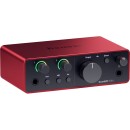
Focusrite Scarlett Solo (4th Generation) |
VS | |||||||||||||
|---|---|---|---|---|---|---|---|---|---|---|---|---|---|---|
| Analog: 2 Inputs / 2 Outputs at 192 kHz |
Channels of I/O |
Analog: 2 Inputs / 2 Outputs at 192 kHz |
Analog: 2 Inputs / 2 Outputs at 96 kHz |
Analog: 1 Input / 2 Outputs |
Analog: 2 Inputs / 2 Outputs at 96 kHz |
1 Input / 2 Output |
Analog: 2 Inputs / 2 Outputs at 192 kHz |
Analog: 2 Inputs / 2 Outputs |
Analog: 2 Inputs / 2 Outputs at 96 kHz |
2 Inputs / 2 Outputs | 1 Input / 2 Outputs | 2 Input / 4 Output |
Analog: 1 Input / 2 Outputs |
Analog: 1 Input / 2 Outputs at 48/96 kHz |
| 192 kHz / 24-Bit | Maximum Sampling Rate | 192 kHz / 24-Bit | 96 kHz / 24-Bit | 192 kHz / 24-Bit | 96 kHz / 24-Bit | 96 kHz / 24-Bit | 192 kHz / 24-Bit | 48 kHz / 16-Bit | 96 kHz / 24-Bit | 48 kHz / 24-Bit | 48 kHz / 24-Bit | 48 kHz / 24-Bit | 192 kHz / 24-Bit | 96 kHz / 24-Bit |
| 1 | Number of Microphone Inputs | 2 | 1 Preamp | 1 Preamp | 2 Preamps | 1 | 1 Preamp | 1 Preamp | 2 Preamps | 2 Preamps | 1 Preamp | 1 Preamp | 1 Preamp | 1 Preamp |
| 1x XLR 3-Pin Balanced Mic Input 1x 1/4" TS Unbalanced Line/Hi-Z Input (Front Panel) 2x 1/4" TRS Balanced Monitor Output 1x 1/4" TRS Headphone Output (Front Panel) |
Analog Audio I/O |
2x XLR 3-Pin Balanced Mic Input 2x 1/4" TRS Balanced/Unbalanced Line/Hi-Z Input (Front Panel) 2x 1/4" TRS Balanced Monitor Output 1x 1/4" TRS Headphone Output (Front Panel) |
1x Combo XLR-1/4" TRS Balanced Mic/Line Input 1x 1/4" TRS Unbalanced Hi-Z Input (Front Panel) 2x 1/4" TRS Balanced Monitor Output 1x 1/4" TRS Unbalanced Headphone Output (Front Panel) 1x 1/8" / 3.5 mm TRS Unbalanced Headphone Output (Front Panel) |
1x Combo XLR-1/4" TRS Balanced/Unbalanced Mic/Line/Hi-Z Input (Front Panel) 2x 1/4" TRS Balanced Monitor Output 1x 1/4" TRS Unbalanced Headphone Output (Front Panel) |
2x Combo XLR-1/4" TS Balanced/Unbalanced Mic/Hi-Z Input (Pin 2 Hot) 2x 1/4" TRS Balanced Line/Monitor Output 1x 1/4" TRS Unbalanced Headphone Output |
1x Combo XLR-1/4" TRS Mic/Line Input 2x 1/4" TRS Balanced Line Output 1x 1/4" TRS Headphone Output |
1x Combo XLR-1/4" TRS Balanced Mic/Line Input 1x 1/4" TS Unbalanced Hi-Z Input (Front Panel) 2x 1/4" TRS Balanced Line Output 1x 1/4" TRS Unbalanced Headphone Output (Front Panel) |
1x Combo XLR-1/4" TRS Balanced Mic/Line Input (Front Panel) 1x 1/4" TRS Balanced/Unbalanced Line/Hi-Z Input (Front Panel) 1x Stereo RCA Coaxial Unbalanced Monitor Output 1x 1/8" / 3.5 mm TRS Unbalanced Headphone Output (Front Panel) |
2x Combo XLR-1/4" TRS Balanced Mic/Line Input 1x 1/4" TS Unbalanced Hi-Z Input 2x 1/4" TRS Balanced Monitor Output 1x 1/4" TRS Unbalanced Headphone Output |
2x 1/8" / 3.5 mm TRRS Unbalanced Mic Input 1x 1/8" / 3.5 mm TRS Unbalanced Headphone Output |
1x XLR 3-Pin Balanced Mic Input 1x 1/8" / 3.5 mm TRRS Unbalanced Smartphone In/Out 1x 1/4" TRS Unbalanced Headphone Output 2x 1/4" TRS Balanced Monitor Output 1x 1/8" / 3.5 mm TRS Unbalanced Main Output |
1x XLR 3-Pin Mic Input 1x 1/4" TS Hi-Z Input 2x 1/4" TRS Balanced Monitor Output 1x 1/4" TRS Headphone Output |
1x Combo XLR-1/4" TRS Balanced/Unbalanced Mic/Line/Hi-Z Input (Front Panel) 2x 1/4" TRS Balanced Line Output 1x 1/4" TRS Unbalanced Headphone Output (Front Panel) |
1x XLR 3-Pin Balanced Mic Input 1x 1/8" / 3.5 mm TRS Headphone Output |
| Digital Audio I/O | - | - | - | - | - | - | - | - | - | - | - | |||
| 1x USB-C | Host Connection | 1x USB-C | 1x USB-C | 1x USB-C | 1x USB-B | USB-C | 1x USB-C (Class-Compliant) | 1x USB-B (Class-Compliant) | 1x USB-C | 1x USB-C (Class-Compliant) | 1x USB-C (Class-Compliant) |
1x USB-A 1x USB-B |
1x USB-C | 1x USB-C |
| macOS Windows |
OS Compatibility |
macOS Windows |
macOS 10.11.6 or Later macOS 11.1 or Later Windows 7 or Later 6 or Later iPadOS |
macOS 10.14 or Later Windows 10 (64-Bit Only) 14 or Later iPadOS 14 or Later |
macOS 10.11 or Later (64-Bit Only) Windows 7 or Later (32-/64-Bit) |
macOS 10.10 or Later Windows 7 or Later |
macOS 10.8 or Later Windows 7 or Later |
macOS 10.8 or Later Windows 7 or Later (32-/64-Bit) |
macOS 10.7.5 or Later Windows 7 or Later (32-/64-Bit) 6 or Later |
macOS 11 Windows 10.19,041 14 9.0 |
macOS Windows iPadOS |
macOS 10.13 (64-Bit Only) Windows 10 (64-Bit Only) 9 or Later |
macOS Windows |
Windows 10 |
| USB Bus Power, USB Power Adapter (Not Included) | Power Requirements | USB Bus Power, USB Power Adapter (Not Included) | USB Bus Power | AC/DC Power Adapter (Not Included) or USB Bus Power | USB Bus Power | USB Bus Power | USB Bus Power | USB Bus Power | USB Bus Power | USB Bus Power | AC/DC Power Adapter (Not Included) or USB Bus Power | USB Bus Power | USB Bus Power | USB Bus Power |
